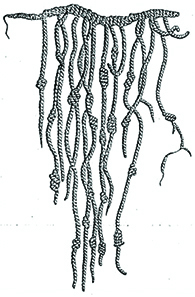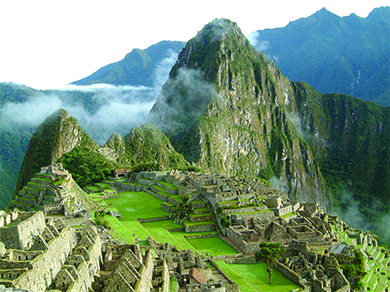| << Chapter < Page | Chapter >> Page > |

The Inca people worshipped their lord who, as a member of an elite ruling class, had absolute authority over every aspect of life. Much like feudal lords in Europe at the time, the ruling class lived off the labor of the peasants, collecting vast wealth that accompanied them as they went, mummified, into the next life. The Inca farmed corn, beans, squash, quinoa (a grain cultivated for its seeds), and the indigenous potato on terraced land they hacked from the steep mountains. Peasants received only one-third of their crops for themselves. The Inca ruler required a third, and a third was set aside in a kind of welfare system for those unable to work. Huge storehouses were filled with food for times of need. Each peasant also worked for the Inca ruler a number of days per month on public works projects, a requirement known as the mita . For example, peasants constructed rope bridges made of grass to span the mountains above fast-flowing icy rivers. In return, the lord provided laws, protection, and relief in times of famine.
The Inca worshipped the sun god Inti and called gold the “sweat” of the sun. Unlike the Maya and the Aztecs, they rarely practiced human sacrifice and usually offered the gods food, clothing, and coca leaves. In times of dire emergency, however, such as in the aftermath of earthquakes, volcanoes, or crop failure, they resorted to sacrificing prisoners. The ultimate sacrifice was children, who were specially selected and well fed. The Inca believed these children would immediately go to a much better afterlife.
In 1911, the American historian Hiram Bingham uncovered the lost Incan city of Machu Picchu ( [link] ). Located about fifty miles northwest of Cusco, Peru, at an altitude of about 8,000 feet, the city had been built in 1450 and inexplicably abandoned roughly a hundred years later. Scholars believe the city was used for religious ceremonial purposes and housed the priesthood. The architectural beauty of this city is unrivaled. Using only the strength of human labor and no machines, the Inca constructed walls and buildings of polished stones, some weighing over fifty tons, that were fitted together perfectly without the use of mortar. In 1983, UNESCO designated the ruined city a World Heritage Site.

Browse the British Museum’s World Cultures collection to see more examples and descriptions of Incan (as well as Aztec, Mayan, and North American Indian) art.
With few exceptions, the North American native cultures were much more widely dispersed than the Mayan, Aztec, and Incan societies, and did not have their population size or organized social structures. Although the cultivation of corn had made its way north, many Indians still practiced hunting and gathering. Horses, first introduced by the Spanish, allowed the Plains Indians to more easily follow and hunt the huge herds of bison. A few societies had evolved into relatively complex forms, but they were already in decline at the time of Christopher Columbus’s arrival.

Notification Switch
Would you like to follow the 'U.s. history' conversation and receive update notifications?